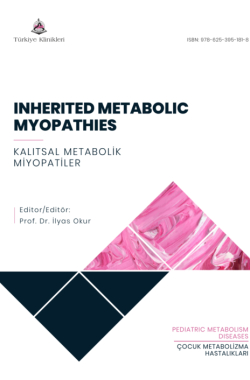Diagnosis Methods of Metabolic Myopathies: Cardiac Evaluation (Electrocardiogram, Echocardiogram)
Fatma HAYVACI CANBEYLİa
aGazi University Faculty of Medicine, Department of Pediatric Cardiology, Ankara, Türkiye
Hayvacı Canbeyli F. Diagnosis methods of metabolic myopathies: Cardiac evaluation (electrocardiogram, echocardiogram). Okur İ, editor. Inherited Metabolic Myopathies. 1st ed. Ankara: Türkiye Klinikleri; 2024. p.77-81.
ABSTRACT
Metabolic myopathies are rare genetic diseases that occur due to disorders of enzymatic pathways involved in muscle cell metabolism. They can be classified into three major groups: disorders of glycogen metabolism, disorders of lipid metabolism, and disorders of the mitochondrial respiratory chain. While it may have severe symptoms in early childhood, there are also late-onset adult types in which symptoms are mild. Cardiac involvement may be dominant in the phenotype or may be detected during routine screening. Cardiac involvement of metabolic myopathies is divided into two main groups: cardiomyopathies and arrhythmias. Some cardiac pathologies are decisive in the mortality and morbidity of the disease, so early diagnosis and treatment is important.
Keywords: Metabolic myopathies; cardiyomyopathy; cardiac evaluation; arrhythmia
Kaynak Göster
Referanslar
- Lilleker JB, Keh YS, Roncaroli F, Sharma R, Roberts M. Metabolic myopathies: a practical approach. Pract Neurol. 2018;18(1):14-26. [Crossref] [PubMed]
- Urtizberea JA, Severa G, Malfatti E. Metabolic Myopathies in the Era of Next-Generation Sequencing. Genes (Basel). 2023;14(5):954. [Crossref] [PubMed] [PMC]
- Llyod DF, Vara R, Mathur S. Cardiac manifestations of inherited metabolic disease in children. Pediatr Int. 2017;59(5):525-9. [Crossref] [PubMed]
- Di Mambro C, Tamborrino PP, Silvetti MS, Yammine ML, Marcolin C, Righi D, et al. Progressive involvement of cardiac conduction system in paediatric patients with Kearns-Sayre syndrome: how to predict occurrence of complete heart block and sudden cardiac death? Europace. 2021;23(6):948-57. [Crossref] [PubMed]
- Wolfsdorf JI, Weinstein DA. Glycogen storage diseases. Rev Endocr Metab Disord. 2003;4(1):95-102. [Crossref] [PubMed]
- Gillette PC, Nihill MR, Singer DB. Electrophysiological mechanism of the short PR interval in Pompe disease. Am J Dis Child. 1974;128(5):622-6. [Crossref] [PubMed]
- Priya SK, Stephanie LA, Jose, EA, Pamela A, Deeksha SB, Boney A, et al. Diagnosis and management of glycogen storage disease type I: A practice guideline of the American College of Medical Genetics and Genomics. Genet Med. 2014;16(11):e1. [Crossref] [PubMed]
- Kishnani PS, Steiner RD, Bali D, Berger K, Byrne BJ, Case LE, et al. Pompe disease diagnosis and management guideline. Genet Med. 2006;8(5):267-88. [Crossref] [PubMed] [PMC]
- Elliott P, McKenna WJ. Hypertrophic cardiomyopathy. Lancet. 2004;363: 1881-91. [Crossref] [PubMed]
- Ansong AK, Li JS, Nozik-Grayck E, Ing R, Kravitz RM, Idriss SF, et al. Electrocardiographic response to enzyme replacement therapy for Pompe disease. Genet Med. 2006;8(5):297-301. [Crossref] [PubMed]
- Tabarki B, Mahdhaoui A, Yacoub M, Selmi H, Mahdhaoui N, Bouraoui H, et al. Familial hypertrophic cardiomyopathy associated with Wolff-Parkinson-White syndrome revealing type II glycogenosis. Arch Pediatr. 2002;9(7):697-700. [Crossref] [PubMed]
- Bulkley BH, Hutchins GM. Pompe's disease presenting as hypertrophic myocardiopathy with Wolff-Parkinson-White syndrome. Am Heart J. 1978;96: 246-52. [Crossref] [PubMed]
- Carvalho JS, Matthews EE, Leonard JV, Deanfield J. Cardiomyopathy of glycogen storage disease type III. Heart Vessels. 1993;8:155-9. [Crossref] [PubMed]
- Tada H, Kurita T, Ohe T, Shimomura K, Ishihara T, Yamada Y, et al. Glycogen storage disease type III associated with ventricular tachycardia. Am Heart J. 1995;130:911-2. [Crossref] [PubMed]
- Seol J, Jung S, Koh H,Jung J, Kang Y. Echocardiographic Assessment of Patients with Glycogen Storage Disease in a Single Center. Int J Environ Res Public Health. 2023;20(3):2191. [Crossref] [PubMed] [PMC]
- Fu L, Huang M, Chen S. Primary carnitine deficiency and cardiomyopathy. Korean Circ J. 2013;43:785-92. [Crossref] [PubMed] [PMC]
- Papadopoulou-Legbelou K, Gogou M, Dokousli V, Eboriadou M, Evangeliou A. Dilated cardiomyopathy as the only clinical manifestation of carnitine transporter deficiency. Indian J Pediatr. 2017;84:231-3. [Crossref] [PubMed]
- Cotter DG, Schugar RC, Crawford PA. Ketone body metabolism and cardiovascular disease. Am J Physiol Heart Circ Physiol. 2013;304:H1060-76. [Crossref] [PubMed] [PMC]
- Wanders RJ, Ruiter JP, IJLst L, Waterham HR, Houten SM. The enzymology of mitochondrial fatty acid beta-oxidation and its application to follow-up analysis of positive neonatal screening results. J Inherit Metab Dis. 2010;33(5):479-94. [Crossref] [PubMed] [PMC]
- Xiong D, Huamei H, James J, Tokunaga C, Powers C, Huang Y, et al. Cardiac-specific VLCAD deficiency induces dilated cardiomyopathy and cold intolerance. Am J Physiol Heart Circ Physiol. 2014;306:326-38. [Crossref] [PubMed] [PMC]
- Vockley J, Charrow J, Ganesh J, Eswara M, Diaz GA, McCracken E, et al. Triheptanoin treatment in patients with pediatric cardiomy- opathy associated with long chain-fatty acid oxidation disorders. Mol Genet Metab. 2016;119:223-31. [Crossref] [PubMed] [PMC]
- Bonnett D, Martin D, de Lonlay P, Villain E, Jouvet P, Rabier D, et al. Arrhythmias and conduction defects as presenting symptoms of fatty acid oxidation disorders in children. Circulation. 1999;100:2248-53. [Crossref] [PubMed]
- El-Hattab AW, Adesina AM, Jones J, Scaglia F. MELAS syndrome: clinical manifestations, pathogenesis, and treatment options. Mol Genet Metab. 2015;116(1-2):4-12. [Crossref] [PubMed]
- Wicks EC, Elliott PM. Genetics and metabolic cardiomyopathies. Herz. 2012;37:598-610. [Crossref] [PubMed]
- Vydt TC, de Coo RF, Soliman OI, Ten Cate FC, van Geuns RJM, Vletter WB, et al. Cardiac involvement in adults with m.3243ANG MELAS gene mutation, Am. J. Cardiol. 2007;99(2):264-9. [Crossref] [PubMed]
- Sproule DM, Kaufmann P, Engelstad K, Starc TJ, Hordof AJ, De Vivo DC. Wolff-Parkinson-White syndrome in Patients With MELAS. Arch Neurol. 2007; 64(11):1625-7. [Crossref] [PubMed]
- Oginosawa Y, Abe H, Nagatomo T, Mizuki T, Nakashima Y. Sustained polymor- phic ventricular tachycardia unassociated with QT prolongation or bradycardia in the Kearns-Sayre syndrome. Pacing Clin Electrophysiol. 2003;26:1911-2. [Crossref] [PubMed]
- Imamura T, Sumitomo N, Muraji S, Mori H, Osada Y, Oyanagi T, et al. The neces- sity of implantable cardioverter defibrillators in patients with Kearns-Sayre syndrome - systematic review of the articles. Int J Cardiol. 2019; 279:105-11. [Crossref] [PubMed]
- Chawla S, Coku J, Forbes T, Kannan S. Kearns-Sayre syndrome presenting as complete heart block. Pediatr Cardiol. 2008;29:659-62. [Crossref] [PubMed]

